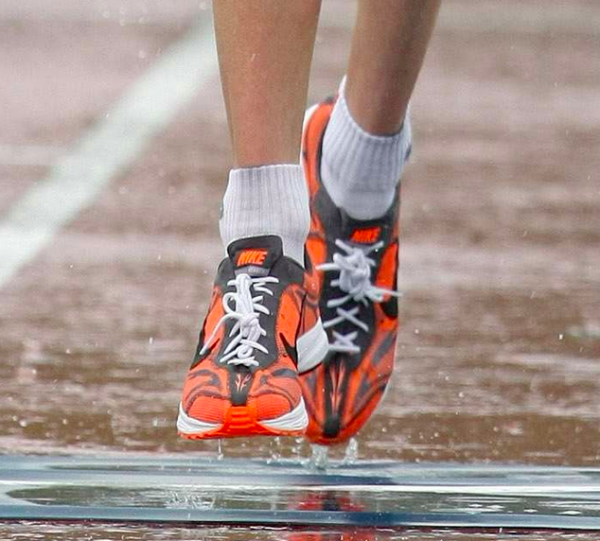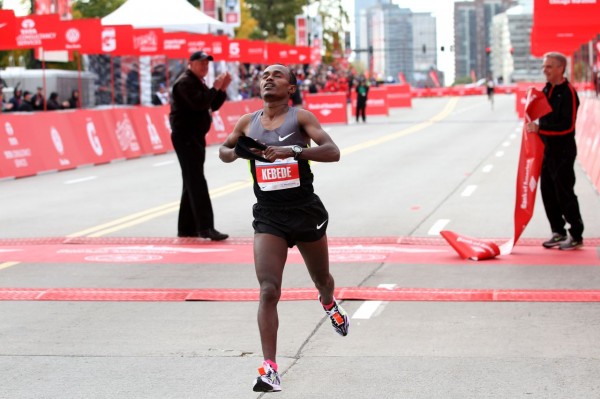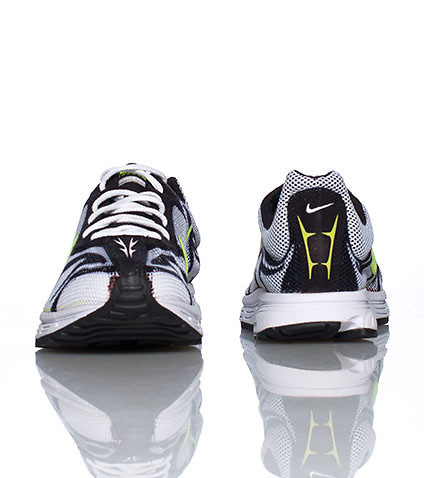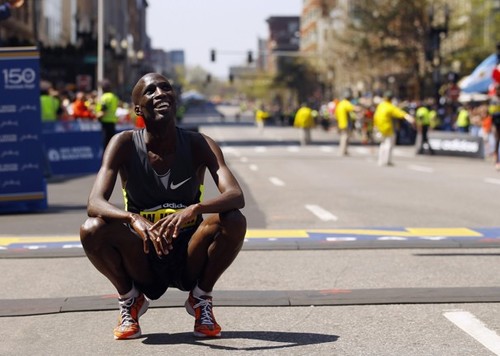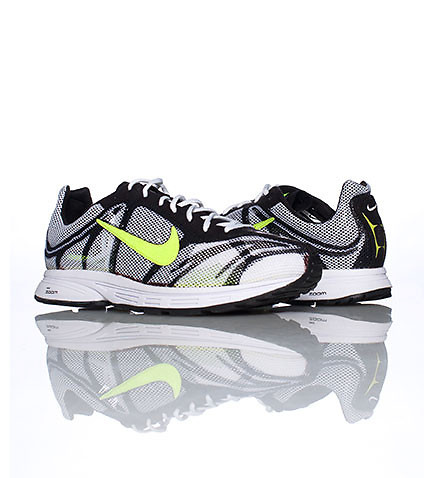Nike Zoom Streak 3 – Relic or Real Deal?
‘What are they?!’
I’d returned to London from New York having run the 2014 marathon and was watching highlights of Kipsang and Desisa. I’d heard they’d had a bit of a duel racing into the finish line, an exciting culmination to what had been a difficult race in blustery conditions. Being the nerd I am, I was ignoring Tim Hutchings babbel about low arm carry and ‘taking it to each other’. I was watching Desisa. And all I was thinking was ‘what are on his feet?’. I knew Kipsang was wearing adidas adios boost 2 – in the build up adidas had made a fairly big deal of it as they had Dennis Kimetto break the world record in the same shoe 5 weeks earlier – but what the hell was Lelisa wearing?! Even in a close up on the podium I was still clutching at straws. As a convert from adidas to Nike, following (in my opinion) the disastrous switch from soling the Adios with ‘Boost’ instead of ‘Adiprene’, I’d been wearing the Nike Flyknit Racer on the assumption that was Nike’s go to marathon shoe. But this footage was evidence to the contrary… time for some investigative shoe journalism.
Soon after I stumbled on the following article from Sneaker Report. It documents the first 100 shoes that crossed the line that day. I came to find that the shoe Desisa had worn to 2nd place was the Nike Zoom Streak 3. 3? A few months earlier I had purchased the Zoom Streak 5 as a possible alternative to the Flyknit Racer. So why was he running in the 3? It turned out he wasn’t the only one. Stephen Kiprotich, 5th, also wore the shoe. 13th and 14th place Biranhu Kemal and Micah Kogo… that’s 4 of the top 20 in the men’s race! The same for the women, 7th place Firehiwot Dado and 10th place Buzunesh Deba wearing the ZS3. There were a few Zoom Streak 4’s and 5’s on display but mostly it was the older Zoom Streak 3 shoe that Nike athletes were wearing that day…
Maybe this was a trend thing I thought. Or maybe, if it was the Zoom Streak that Nike were having their athletes wear, they’d had a production problem with the 5’s. And the 4’s. And had to dish out some of the last pairs of 3’s they’d managed to find in time for the race? Unlikely. I dug a little deeper. Turns out the year before Sneaker Report conducted the same study. Low and behold for both the men’s and women’s race 3 of the top 10 finishers, 6 of 20 athletes, were in the Zoom Streak 3! So no fluke.
It seems for a number of years whilst other manufacturers have had athletes wear the latest incarnation of a racing shoe, the go to amongst Nike sponsored long distance runners has remained the Zoom Streak 3. Not taking my word for it? More evidence needed? Here’s a list, an impressive one, of top marathoners who have remained loyal to the shoe: Tsegaye Kebede, Dickson Chumba, Ayele Abshero, Stanley Biwott, Wesley Korir, Rita Jeptoo, Priscah Jeptoo, Florence Kiplagat… So what is the shoe all about, where has it come from, how does it differ from the latest version and why are Nike and it’s athletes sticking with it?
An indication of when elite runners received a pair, April 2009, nearly 6 years ago! It still uses Nike Zoom Air technology in the sole (conceived by Nike in 1995), it weighs 6.7oz (about 180g), stack height is 30mm-18mm heel to forefoot, a 12mm differential. OK, great, but nothing has changed in the newer versions 4 and 5. Same sole, same stack height, roughly the same weight… So what’s the difference? Why are these top athletes still wearing the 2010 shoe rather than the 2015 update?
Well I thought, as I own the Zoom Streak 5 (see review) why not procure a pair of the Zoom Streak 3 and find out. Easier said than done… online retailers in UK? Nope. US? Nope. eBay? Nope. Nike directly? Nope. 3 months went past and I nearly gave up all hope. Then I was lucky enough to stumble upon a pair of the shoes at a store in London. Apparently when moving premises they had found some old stock. Not only that but they had my size. And only for £56! So finally I can now make the comparison.
Weirdly perhaps, given the similarities noted above, the shoe does run differently. The first noticeable change is the upper, a firmer see-through mesh in the ZS3 as opposed to the softer engineered mesh on the ZS5. This brings two benefits to the ZS3 in my opinion. Firstly the shoe offers a little more rigidity – one of the criticisms I had with the ZS5 was that the foot would slip because the upper material is so soft, the new ‘Flywire’ technology offering no saving grace here… Secondly, the ZS3 has sort of a midfoot torsion system which is missing on the ZS5. This makes the shoe a little less flexible but at the same time makes the ride firmer, perhaps providing a little more ‘pop’. And erm that’s about it. But it does feel different! For whatever reason the Zoom Streak 3 feels more responsive. True it doesn’t ‘disappear’ on your foot, you have to lace it up properly and there is no heel counter so it can also feel like it’s slipping at the back. But maybe because of that it feels more… I don’t know, authentic? Most of all, it feels hard and fast. Winner for me.
What’s clear is that the Zoom Streak 3 is the go to shoe for Nike marathoners and Nike are happy keeping it that way. Whether this is based on athlete feedback, as above, I don’t know. Maybe they generate enough revenue from other shoes they retail so as not to be reliant on their elite athletes getting them ‘shoe specific sales’, who knows. I offer this supposition as a comparison to the adidas business model. The original adidas Adios in which Gebrselassie (v1) and Makau (v2) broke the world record was actually a super successful shoe and in fact quite similar to the Zoom Streak 3 in construction – racing flat, hard EVA platform, super breathable and lightweight mesh upper, similar midsole offset. But adidas retired the shoe in favour of the Boost. No doubt the Boost is having it’s own successes, Kipsang and Kimetto following adidas tradition of breaking world records in Boost v1 and v2 respectively. But adidas do seem super reliant on their elite athletes promoting the shoe and ‘new technologies’ to drive sales. I personally am an advocate of the natural feeling your body receives when foot striking. You get that with the original Adios. You don’t get it with the Boost. Which is why, in my opinion, adidas shouldn’t have turned their back on what was for me a winning formula. You know what other shoe you get that natural feeling, that feedback from… the Nike Zoom Streak 3…
Some deliberation and mileage is going to have to go toward deciding whether I run my next marathon in my new (old) Zoom Streak 3’s. The Nike Flyknit Racer, which I’ve marathoned in twice, has a similar profile. Namely it’s a firm racing flat, capable of marathon distance, with a super lightweight breathable upper. Maybe I should stick to what I know. But having said that I think the ZS3’s, whilst offering a little more underfoot, do have that ‘pop’ that maybe the FKR doesn’t… And to be fair if Tsegaye and Wesley have stuck with the same shoe for 5 years there must be something to say for them. That’s maybe the real ‘boost’ of confidence I need to take them on.
flyknitLelisa Desisanike flyknitNike RunningNike Zoom StreakNike Zoom Streak 3Nike Zoom Streak 5Shoe ReviewTsegaye KebadeWesley KorirZoom Streak